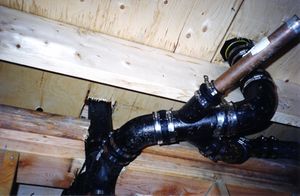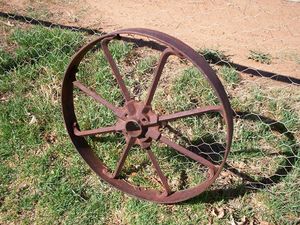حديد زهر
ساهم بشكل رئيسي في تحرير هذا المقال
|
| أطوار سبائك الحديد |
|---|
|
أوستنيت Austenite (حديد-γ؛ صلد) |
| أنواع الصلب |
|
Crucible steel
|
| مواد أخرى أساسها الحديد |
|
حديد زهر (>2.1% كربون) |
الحديد الزهر يسمى أيضا حديد السبك أو حديد الصب (Cast Iron)، و يعرف بحسب مجمع اللغة العربية بالقاهرة كما يلى:
- الحديد الناتج من صهر الخام في الأفران العالية وهوحديد غير نقي سهل الكسر و لا يقبل التشكيل، يبدأ في الانصهار عند 1270 درجة مئوية.
- أشابة من الحديد معدة للصب، تشتمل على بعض العناصر الأخرى.
- الحديد الناتج من الأفران العالية وتبلغ كثافته 7.86 جم/سم3، و درجة انصهاره ما بين 1275 إلى 1505ْم، وهو سهل الكسر و لا يقبل التشكيل.
- حديد يحتوي على نسبة كربون تفوق حد ذوبانه في طور الأوستنيت عند درجة حرارة اليوتكتي فينفصل الكربون في صورة قشور أو شبه كريات (حديد زهر رمادي) أو قد يكوّن سمنتيتاً (حديد زهر أبيض).
- نوع من الحديد غير النقى ينتج بصهر حديد الزهر مع الجير ثم صبه في قوالب ، وهو قصيف ولكنه يتميز بصلادته.
تنويعات من الحديد الزهر
حديد زهر رمادي

 مقالة مفصلة: حديد رمادي
مقالة مفصلة: حديد رمادي
سبائك حديد زهر أخرى

حديد زهر طروق (Malleable Cast Iron) أو زهر طروق أسود القلب (Blackheart Malleable Cast Iron)، و هو أحد أنواع حديد الزهر الملدن انتقص كربونه (جرافيته) من السطح دون القلب فيصبح أبيض السطح أسود القلب و ذلك عن طريق المعالجة الحرارية.
Malleable iron starts as a white iron casting, that is then heat treated at about 900 °C. Graphite separates out much more slowly in this case, so that surface tension has time to form it into spheroidal particles rather than flakes. Due to their lower aspect ratio, spheroids are relatively short and far from one another, and have a lower cross section vis-a-vis a propagating crack or phonon. They also have blunt boundaries, as opposed to flakes, which alleviates the stress concentration problems faced by grey cast iron. In general, the properties of malleable cast iron are more like mild steel. There is a limit to how large a part can be cast in malleable iron, since it is made from white cast iron.
حديد لدن (Ductile Iron) أو يسمى حديد زهر كروى الجرافيت (Spheroidal-Graphite Cast Iron) أو حديد زهر عقدى (Nodular Cast Iron) و هو حديد زهر متكور ما فيه من الجرافيت ينتج بإضافة عناصر كالمغنسيوم أو البريوم إلى مصهوره فتساعد هذه العناصر على تكور الجرافيت المنفصل، فيكتسب الحديد نسبياً لدونة ومتانة.
A more recent development is nodular or ductile cast iron. Tiny amounts of magnesium or cerium added to these alloys slow down the growth of graphite precipitates by bonding to the edges of the graphite planes. Along with careful control of other elements and timing, this allows the carbon to separate as spheroidal particles as the material solidifies. The properties are similar to malleable iron but parts can be cast with larger sections.

| الاسم | التركيبة الاسمية [% بالوزن] | Form and condition | Yield strength [ksi (0.2% offset)] | Tensile strength [ksi] | الاستطالة (% (في 2 بوصة)) | Hardness (مقياس برينل) | الاستخدامات |
|---|---|---|---|---|---|---|---|
| حديد زهر رمادى (ASTM A48) | C 3.4, Si 1.8, Mn 0.5 | Cast | — | 25 | 0.5 | 180 | جسم (كتلة) المحرك , fly-wheels, gears, machine-tool bases |
| أبيض | C 3.4, Si 0.7, Mn 0.6 | Cast (as cast) | — | 25 | 0 | 450 | Bearing surfaces |
| حديد زهر طروق (ASTM A47) | C 2.5, Si 1.0, Mn 0.55 | Cast (annealed) | 33 | 52 | 12 | 130 | Axle bearings, track wheels, automotive crankshafts |
| حديد زهر لدن أو عقدى | C 3.4, P 0.1, Mn 0.4, Ni 1.0, Mg 0.06 | Cast | 53 | 70 | 18 | 170 | Gears, cams, crankshafts |
| حديد زهر لدن أو عقدى
(ASTM A339) |
— | Cast (quench tempered) | 108 | 135 | 5 | 310 | — |
| Ni-hard type 2 | C 2.7, Si 0.6, Mn 0.5, Ni 4.5, Cr 2.0 | Sand-cast | — | 55 | – | 550 | القوة |
| Ni-resist type 2 | C 3.0, Si 2.0, Mn 1.0, Ni 20.0, Cr 2.5 | Cast | — | 27 | 2 | 140 | Resistance to heat and corrosion |
الاستخدامات التاريخية
Because cast iron is comparatively brittle, it is not suitable for purposes where a sharp edge or flexibility is required. It is strong under compression, but not under tension. Cast Iron was first invented in China (see also: Du Shi), and poured into molds to make weapons and figurines. Historically, its earliest uses included cannon and shot. In إنگلترة, the ironmasters of the Weald continued producing these until the 1760s, and this was the main function of the iron industry there after the Restoration, though probably only a minor part of the industry there earlier.
انظر أيضاً:
المصادر
- معجم المصطلحات العلمية التى أقرها مجمع اللغة العربية بالقاهرة
- John Gloag and Derek Bridgwater, A History of Cast Iron in Architecture, Allen and Unwin, London (1948)
- Peter R Lewis, Beautiful Railway Bridge of the Silvery Tay: Reinvestigating the Tay Bridge Disaster of 1879, Tempus (2004) ISBN 07524 3160 9
- Peter R Lewis, Disaster on the Dee: Robert Stephenson's Nemesis of 1847, Tempus (2007) ISBN 0 7524 4266 2
- George Laird, Richard Gundlach and Klaus Röhrig, Abrasion-Resistant Cast Iron Handbook, ASM International (2000) ISBN 0-87433-224-9
- ^ Lyons, William C. and Plisga, Gary J. (eds.) Standard Handbook of Petroleum & Natural Gas Engineering, Elsevier, 2006


